PreSonus Studio 24c Manual
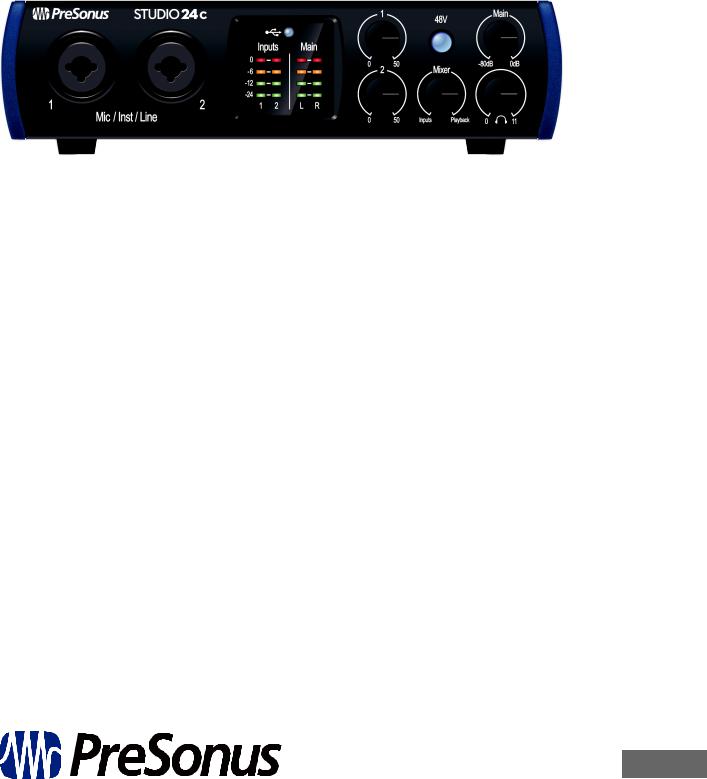
Studio 24c
24-Bit, 192 kHz USB-C Audio Interface
Owner’s Manual
®
www.presonus.com
English

Table of Contents
1Overview — 1
1.1Introduction — 1
1.2What is in the Box — 1
1.3Companion PreSonus Products — 2
2Hookup — 3
2.1Front-Panel Connections — 3
2.2Back Panel Connections — 4
2.3Connection Diagram — 5
3Connecting to a Computer — 6
3.1Installation for Windows — 6
3.1.1Universal Control (Windows) — 6
3.1.2Loopback Recording (Windows only) — 8
3.2Installation for macOS — 9
3.3Using the Studio 24c with Popular Audio Applications — 9
4Studio One Artist Quick Start — 11
4.1Installation and Authorization — 11
4.2Setting Up Studio One — 12
4.2.1Configuring Audio Devices — 13
4.2.2Configuring MIDI Devices — 13
4.3Creating a New Song — 17
4.3.1Configuring Your I/O — 18
4.3.2Creating Audio
and Instrument Tracks — 19
4.3.3Recording an Audio Track — 20
4.3.4Adding Virtual Instruments and Effects — 21
5Technical Information — 23
5.1Specifications — 23
6Warranty — 24
6.1Warranty Information — 24

1 |
Overview |
Studio 24c |
1.1 |
Introduction |
Owner’s Manual |
1Overview
1.1Introduction
Thank you for purchasing a PreSonus® Studio 24c audio interface. PreSonus Audio Electronics, Inc., has designed the Studio 24c utilizing high-grade components to ensure optimum performance that will last a lifetime. Loaded with high-headroom, Class A microphone preamplifiers; robust metering, highdefinition 24-bit, 192 kHz conversion; and more, the Studio 24c breaks new boundaries for music performance and production. All you need is a computer with a USB-C or USB-A (2.0 or 3.0) connection, a few microphones and cables, powered speakers, and your instruments, and you are ready to record!
We suggest that you use this manual to familiarize yourself with the features, applications, and correct connection procedures for your Studio 24c audio interface before trying to connect it to your computer. This will help you avoid problems during installation and setup.
Throughout this manual you will find Power User Tips that can quickly make you a Studio 24c interface expert.
1.2What is in the Box
Your Studio 24c package contains:
•Studio 24c 24-bit, 192 kHz audio interface
• Quick Start Guide
Studio 2|4 24-Bit 192 kHz
USB-C Audio Interface
Getting Started
Package Contents
Downloads
Before operating your Studio 2|4, you must register online for software downloads, Owner’s Manual, and instructional video.
1
2
3
4
5
6
7
Studio 2|4 USB - Interfaz de Audio USB-C a 24 Bits / 192 kHz
Comenzando
Contenido del paquete
Descargas
Antes de operar su Studio 2|4, primero debe registrarse online para descargar el software, Manual de usuario y video instructivo.
1
2
3
4
5
6
7
•1M USB-C to C Cable
•1M USB-C to A Cable
•PreSonus Health Safety and Compliance Guide
Power User Tip: All companion software and drivers for your PreSonus Studio 24c are available for download from your My PreSonus user account. Please visit http://my. presonus.com and register your Studio 24c to receive downloads and licenses.
1
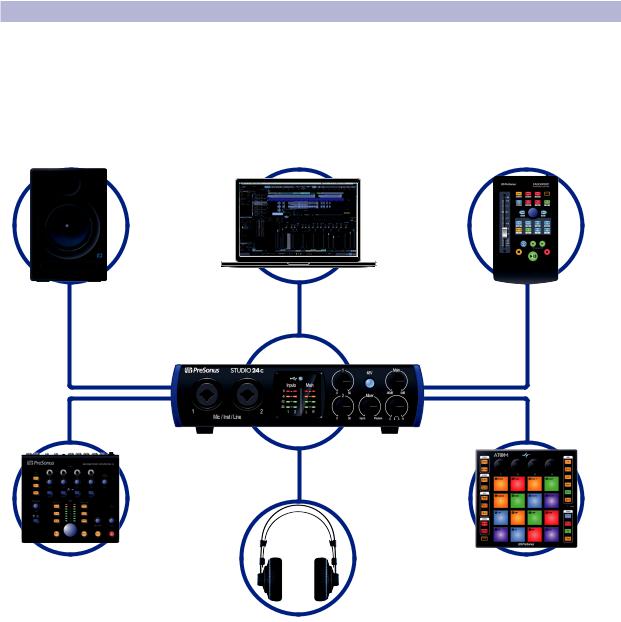
1 |
Overview |
Studio 24c |
1.3 |
Companion PreSonus Products |
Owner’s Manual |
1.3Companion PreSonus Products
Thanks for choosing PreSonus! As a solutions company, we believe the best way to take care of our customers (that’s you) is to ensure that you have the best possible experience from the beginning of your signal chain to the end. To achieve this goal, we’ve prioritized seamless integration throughout every design phase of these products from day one. The result is systems that communicate with each other
as intended—straight out of the box—without excessive configuration hassles. We’re here for you. Find out more at www.presonus.com.
2
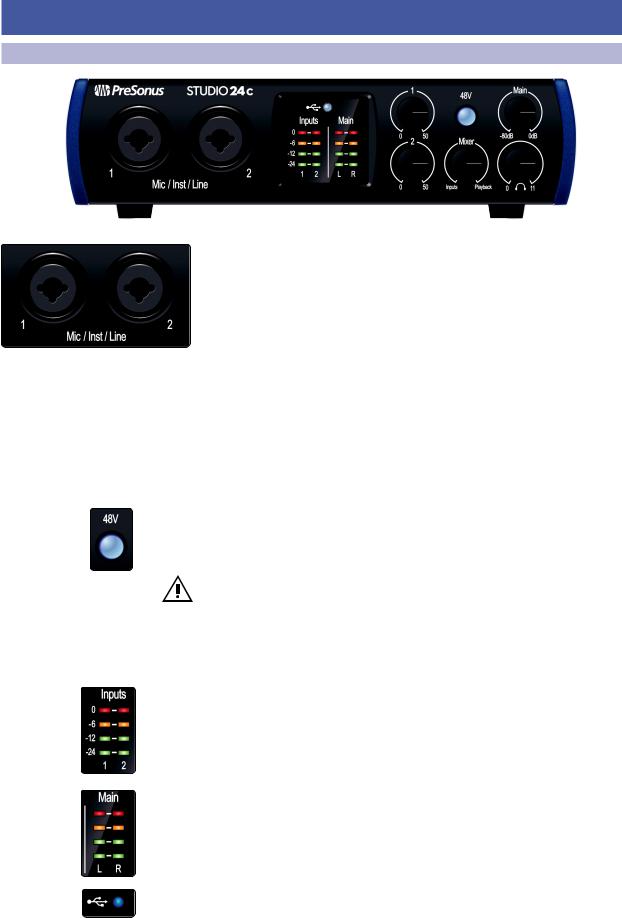
2 |
Hookup |
Studio 24c |
2.1 |
Front-Panel Connections |
Owner’s Manual |
2Hookup
2.1Front-Panel Connections
Microphone Inputs. Your Studio 24c interface is equipped with highquality microphone preamplifiers for use with all types of microphones. The Studio 24c features XMAX-L solid-state microphone preamps that are optimized for bus powering.
Both input channels on your Studio 24c interface are equipped with combo jacks. This convenient connector accepts either a ¼-inch or an XLR connector.
Instrument / Line-Level Inputs. The ¼-inch connectors on Channels 1 and 2 can be used with passive instruments (guitar, bass, etc.)
or line-level devices (synthesizers, signal processors, etc.).
Please note: As with any audio input device, plugging in a microphone or an instrument, or turning phantom power on or off, will create a momentary spike in the audio output. Because of this, we highly recommend that you turn down the channel trim before changing connections or turning phantom power on or off. This simple step will add years to life of your audio equipment.
48 Volt Phantom Power. The Studio 24c provides 48V phantom power for the microphone inputs. Pressing the 48V button switches phantom power on and off for all microphone inputs; the button will illuminate in blue when phantom power is available on the microphone preamplifiers.
WARNING: Phantom power is only required for condenser microphones and can severely damage some dynamic mics, especially ribbon mics. Therefore, switch phantom power off when it is not required. Consult the user documentation
that came with your microphone before engaging phantom power.
XLR connector wiring for phantom power: Pin 1 = GND Pin 2 = +48V Pin 3 = +48V
Input Meters. These LED meters show the input level of the analog inputs on your
Studio 24c. The red Clip LED will illuminate when your input signal reaches -0.5 dBFS. At this level, the signal will begin to overload the analog-to-digital converters and exhibit signs of clipping. Use the gain controls to keep the signal below this level.
Output Meters. These meters display the signal level received from the first two driver returns (Main Left/Right). These meters have the same range as the input meters and display the signal level before the main output level control.
Sync LED. This light indicates if your Studio 24c is in sync with your computer. When no sync is available, this light will flash red.
3
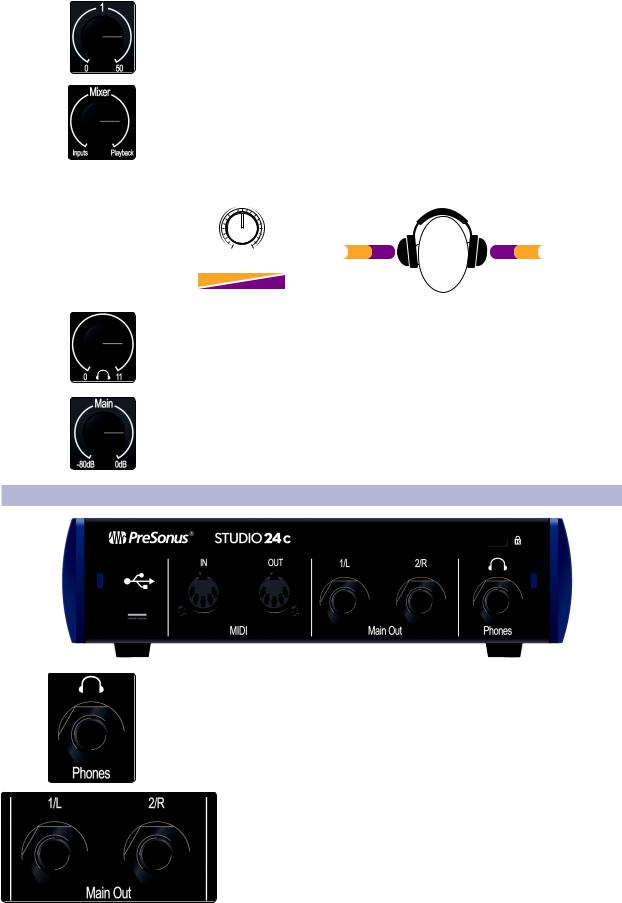
2 |
Hookup |
Studio 24c |
2.2 |
Back Panel Connections |
Owner’s Manual |
Input Gain Control. These knobs provide 50 dB of variable gain (0 to +50 dB for microphones, -15 to 35 dB for line/instrument).
Mixer. The Mixer knob allows you to blend your input signals with the playback streams from your computer so that you can monitor your input signals without any latency (delay). If the knob is positioned at 12 o’clock, the input signal and the playback stream will be equally balanced. Turning the knob to the left will increase the level of the input signal relative to the playback stream; turning to the right will increase the level of the playback stream relative to the input signal as illustrated below:
Inputs Playback
Inputs Playback
Headphone Level. This knob controls the level of the rear panel headphone output.
Main. The main knob controls the output level for the main left/right outputs on the back of your Studio 24c and has a range of -80 dB to 0 dB. This control provides attenuation only.
2.2Back Panel Connections
Headphone Output. The rear-panel headphone output mirrors the same streams as the Main left/right outputs.
Main Outs. These are the Main outputs for the Studio 24c. The output level of the Main outputs is controlled by the Main level control on the front of the unit. Playback streams 1 and 2 are routed to these outputs.
4
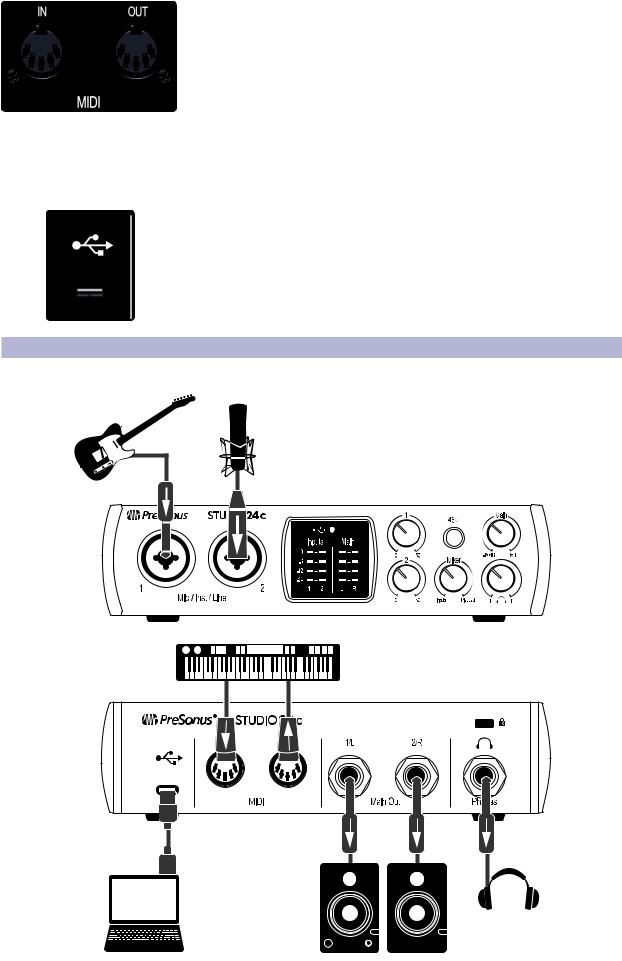
2 |
Hookup |
Studio 24c |
2.3 |
Connection Diagram |
Owner’s Manual |
MIDI I/O. This is the MIDI input and output connections.
MIDI stands for“Musical Instrument Digital Interface.”However, MIDI can be used for many things other than instruments and sequencing. The MIDI inputs and outputs allow connection to a variety of MIDIequipped hardware, such as keyboard controllers, and can be used to send and receive MIDI Machine Control and MIDI Time Code.
Note: MIDI does not carry audio signals but is frequently used to trigger or control an audio source, such as a virtual instrument or hardware synthesizer. You should ensure that MIDI data is correctly sent and received by the appropriate hardware or software. You may also need to route hardware sound sources’ audio to the inputs of your Studio-series interface. Please consult the User’s Manual of your MIDI devices for help with MIDI setup and usage.
USB-C Port. Use this port to connect your Studio 24c to your computer. While the Studio 24c connects using USB-C, it is fully compatible with USB 2.0 and 3.0 connections. Use the USB-C to A cable that came with your Studio 24c if your computer has a USB-A connection rather than a USB-C connection.
Please note: The Studio 24c is backward compatible with USB 2.0 and USB 3.0 speed connections. USB 1.1 is not supported.
2.3Connection Diagram
5
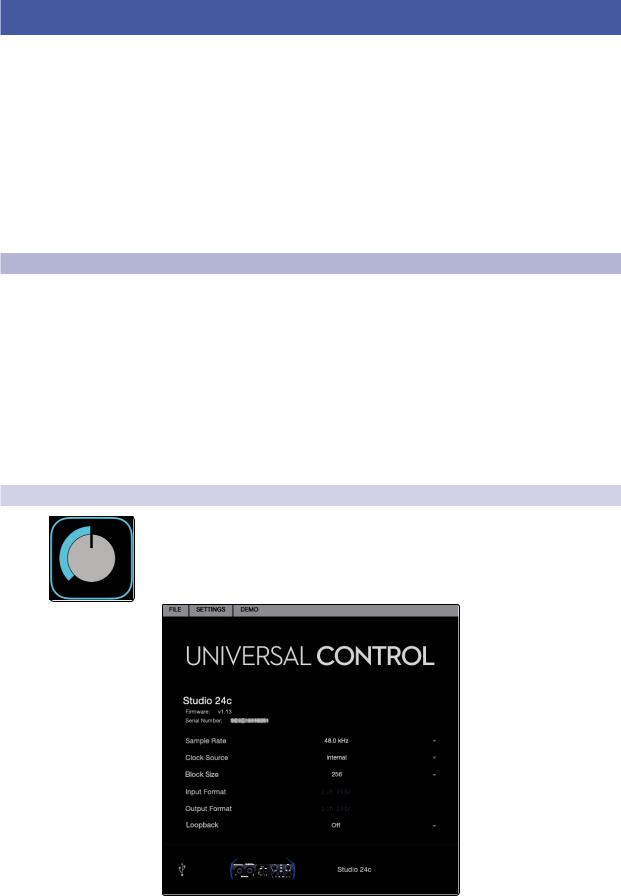
3 |
Connecting to a Computer |
Studio 24c |
3.1 |
Installation for Windows |
Owner’s Manual |
3 Connecting to a Computer
Before connecting your Studio 24c to a computer, please visit www.presonus.com to verify the latest system requirements.
Note: The speed of your processor, amount of RAM, and capacity, size, and speed of your hard drives will greatly affect the overall performance of your recording system. A faster processor and more RAM can reduce signal latency (delay) and improve overall performance.
The Universal Control installers for macOS and Windows are available from your My PreSonus user account. The Windows installer also includes the Windows ASIO driver. No driver installation is necessary for macOS. To begin, you must first visit http://my.presonus.com, create or log into your user account, and register your
Studio 24c. Once registered, all software downloads will be available from within your My PreSonus user account including Studio One Artist and the Studio Magic bundle.
3.1Installation for Windows
Download the Universal Control installer from your My PreSonus account. Connect your Studio 24c to an available USB-C or USB-A (2.0 or 3.0) port and launch the installer. The installer will take you through each step of the installation process. This application will install the ASIO and WDM drivers, as well as Universal Control. Please read each message carefully.
It is recommended that you quit all applications before you start the installation.
The Universal Control installer will take you through each step of the installation process. Please read each message carefully so that you do not connect your Studio 24c too soon.
Power User Tip: It is recommended that you temporarily disable or turn off any anti-virus programs you have running to prevent installation issues.
3.1.1 Universal Control (Windows)
Universal Control is a powerful hardware-management application for all PreSonus interface products. It allows you to view any PreSonus interface product connected to your computer or your computer’s network.
When Universal Control is launched, you will see the Launch window. From this window, you can manage all the ASIO driver settings.
Sample Rate. Changes the sample rate.
You can set the sample rate to 44.1, 48, 88.2, 96, 176.4, or 192 kHz. A higher sample rate will increase the fidelity of the recording but will increase the file size and the amount of system resources necessary to process the audio.
6
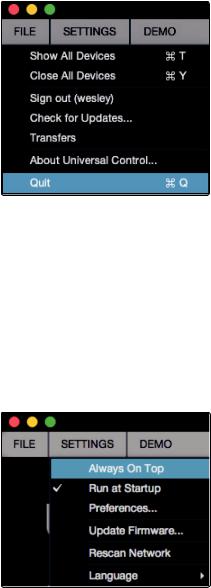
3 |
Connecting to a Computer |
Studio 24c |
3.1 |
Installation for Windows |
Owner’s Manual |
Block Size. Sets the buffer size.
From this menu, you can set the buffer size. Lowering the buffer size will lower latency; however, this will also increase performance demands on your computer. In general, you will want to set the buffer size as
low as your system can safely support. If you begin to hear pops, clicks, or distortion in your audio path, try raising the buffer size.
Loopback (Windows only). The Studio 24c ASIO driver provides two loopback streams to record audio from one application
to another. See Section 3.1.2 for more information.
File Menu. Manages devices connected to Universal Control.
•Show All Devices. Launches all control windows for all supported devices connected to your computer.
•Close All Devices. Closes all open control windows.
•Sign Out. Signs out of your My PreSonus user account.
•Check for Updates... Connects to your My PreSonus user account to check for updates for Universal Control.
•Transfers. Displays recent downloads from your my PreSonus user account.
•About Universal Control. Displays version and build date information.
•Quit. Quits the Universal Control application and all hardware control windows.
Settings Menu. Provide customization options to personalize your Universal Control experience.
•Always on Top. Keeps the Universal Control Launch window on top whether it is the currently active application or not.
•Run at Startup. Launches Universal Control automatically when your computer boots.
•Preferences. Sets language and appearance options (see below).
•Rescan Network. Scans the network and local transport bus (USB or FireWire) for all supported PreSonus products.
•Language. Sets the language (English, French, German, Korean, Simplified Chinese, or Spanish).
7
